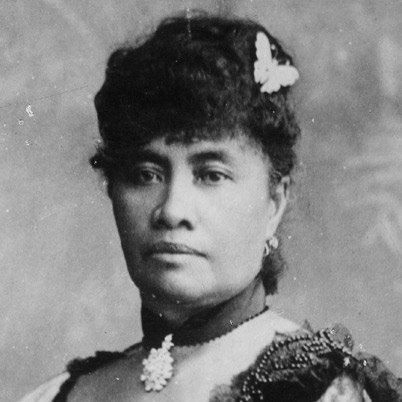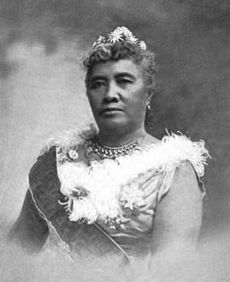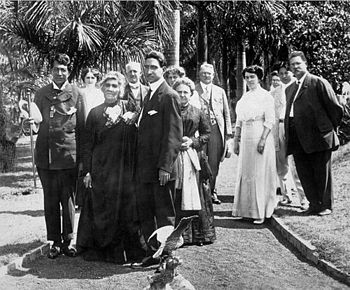Jan 17, 1893: Americans Overthrow Hawai’ian Monarchy
HISTORY, 12 Jan 2015
History & Wikipedia – TRANSCEND Media Service
On the Hawai’ian Islands, a group of American sugar planters under Sanford Ballard Dole overthrow Queen Liliʻuokalani, the Hawai’ian monarch, and establish a new provincial government with Dole as president. The coup occurred with the foreknowledge of John L. Stevens, the U.S. minister to Hawai’i, and 300 U.S. Marines from the U.S. cruiser Boston were called to Hawai’i, allegedly to protect American lives.
The first known settlers of the Hawai’ian Islands were Polynesian voyagers who arrived sometime in the eighth century, and in the early 18th century the first American traders came to Hawai’i to exploit the islands’ sandalwood, which was much valued in China at the time. In the 1830s, the sugar industry was introduced to Hawai’i and by the mid-19th century had become well established. American missionaries and planters brought about great changes in Hawai’ian political, cultural, economic, and religious life, and in 1840 a constitutional monarchy was established, stripping the Hawai’ian monarch of much of his authority. Four years later, Sanford B. Dole was born in Honolulu, Hawai’i, to American parents.
During the next four decades, Hawai’i entered into a number of political and economic treaties with the United States, and in 1887 a U.S. naval base was established at Pearl Harbor as part of a new Hawai’ian constitution. Sugar exports to the United States expanded greatly during the next four years, and U.S. investors and American sugar planters on the islands broadened their domination over Hawai’ian affairs. However, in 1891 Liliʻuokalani, the sister of the late King Kalakaua, ascended to the throne, refusing to recognize the constitution of 1887 and replacing it with a constitution increasing her personal authority.
In January 1893, a revolutionary “Committee of Safety,” organized by Sanford B. Dole, staged a coup against Queen Liliʻuokalani with the tacit support of the United States.
The Queen was deposed on January 17, 1893, and temporarily relinquished her throne to “the superior military forces of the United States”. She had hoped the United States, like Great Britain earlier in Hawai’ian history, would restore Hawai’i’s sovereignty to the rightful holder.
Queen Liliʻuokalani issued the following statement yielding her authority to the United States Government rather than to the Provisional Government:
I, Liliʻuokalani, by the Grace of God and under the constitution of the Hawai’ian Kingdom, Queen, do hereby solemnly protest against any and all acts done against myself and the constitutional government of the Hawai’ian Kingdom by certain persons claiming to have established a Provisional Government of and for this Kingdom. That I yield to the superior force of the United States of America, whose Minister Plenipotentiary, His Excellency John L Stevens, has caused United States troops to be landed at Honolulu and declared that he would support the said Provisional Government. Now, to avoid any collision of armed forces and perhaps loss of life, I do, under this protest, and impelled by said forces, yield my authority until such time as the Government of the United States shall, upon the facts being presented to it, undo the action of its representative and reinstate me in the authority which I claim as the constitutional sovereign of the Hawai’ian Islands.
On February 1, Minister John Stevens recognized Dole’s new government on his own authority and proclaimed Hawai’i a U.S. protectorate. Dole submitted a treaty of annexation to the U.S. Senate, but most Democrats opposed it, especially after it was revealed that most Hawai’ians did want annexation.
President Grover Cleveland sent a new U.S. minister to Hawai’i to restore Queen Liliʻuokalani to the throne under the 1887 constitution, but Dole refused to step aside and instead proclaimed the independent Republic of Hawai’i. Cleveland was unwilling to overthrow the government by force, and his successor, President William McKinley, negotiated a treaty with the Republic of Hawai’i in 1897. In 1898, the Spanish-American War broke out, and the strategic use of the naval base at Pearl Harbor during the war convinced Congress to approve formal annexation. Two years later, Hawai’i was organized into a formal U.S. territory and in 1959 entered the United States as the 50th state.
Liliʻuokalani was arrested on January 16, 1895, several days after the failed 1895 Counter-Revolution in Hawai’i led by Robert William Wilcox, when firearms were found at the base of Diamond Head Crater. She denied any knowledge at her trial, defended by former attorney general Paul Neumann. She was sentenced to five years of hard labor in prison by a military tribunal and fined $5,000, but the sentence was commuted to imprisonment in an upstairs bedroom of ʻIolani Palace, where she composed songs including The Queen’s Prayer (Ke Aloha o Ka Haku) and began work on her memoirs.
During her imprisonment, she abdicated her throne in return for the release (and commutation of the death sentences) of her jailed supporters, including Minister Joseph Nawahi, Prince Kawananakoa, Robert Wilcox, and Prince Jonah Kuhio
She lived in Washington Place until her death on November 11, 1917 due to complications from a stroke. She was 79. She received a state funeral due to her status as a former head of state.
Upon her death, Liliʻuokalani dictated in her will that all of her possessions and properties be sold and the money raised would go to the Queen Liliʻuokalani Children’s Trust to help orphaned and indigent children. The Queen Liliʻuokalani Trust Fund still exists today.
Go to Originals: history.com – wikipedia.org
DISCLAIMER: The statements, views and opinions expressed in pieces republished here are solely those of the authors and do not necessarily represent those of TMS. In accordance with title 17 U.S.C. section 107, this material is distributed without profit to those who have expressed a prior interest in receiving the included information for research and educational purposes. TMS has no affiliation whatsoever with the originator of this article nor is TMS endorsed or sponsored by the originator. “GO TO ORIGINAL” links are provided as a convenience to our readers and allow for verification of authenticity. However, as originating pages are often updated by their originating host sites, the versions posted may not match the versions our readers view when clicking the “GO TO ORIGINAL” links. This site contains copyrighted material the use of which has not always been specifically authorized by the copyright owner. We are making such material available in our efforts to advance understanding of environmental, political, human rights, economic, democracy, scientific, and social justice issues, etc. We believe this constitutes a ‘fair use’ of any such copyrighted material as provided for in section 107 of the US Copyright Law. In accordance with Title 17 U.S.C. Section 107, the material on this site is distributed without profit to those who have expressed a prior interest in receiving the included information for research and educational purposes. For more information go to: http://www.law.cornell.edu/uscode/17/107.shtml. If you wish to use copyrighted material from this site for purposes of your own that go beyond ‘fair use’, you must obtain permission from the copyright owner.


